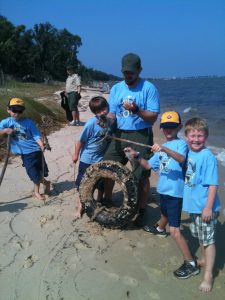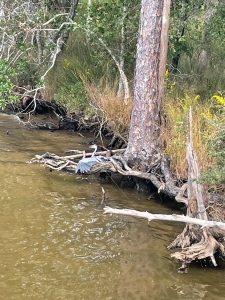
If you’ve ever peeked over the railings of a bridge spanning an urban stream, walked along the beach, or even paddled in some of our more rural rivers, you know we have a trash problem in our waterways. Northwest Florida is crisscrossed by hundreds of small—and large—water bodies that are downstream of all our cities, businesses, homes, and roadways. It’s rare that water bottles, beer cans, and plastic bags are tossed deliberately into the water. More likely, they’re left on playgrounds, fallen out of overflowing garbage cans, or blown out of the backs of trucks. These items are part of an influx of non-point source pollution, which consists of all the contaminants that flow from yards, parking lots, and streets after our rainstorms.

Many of these stormwater contaminants are invisible to the naked eye, including bacteria, nutrients, and heavy metals. But the trash, we can see. Not only is a terrible eyesore, but incredibly hazardous to wildlife. Entanglement and ingestion of plastic waste results in countless fish, bird, and mammal deaths every year. Tiny pieces of broken down microplastics are an emerging and ongoing issue worldwide. It takes 450 years for plastic to decompose, making it an endless problem until it’s removed. Luckily, trash is a relatively low-hanging (or maybe high-floating) fruit of a problem to manage when it comes to removal. While picking up trash is labor-intensive, being the most visible source of pollution makes it one of the easiest to physically extract.

Just over the state line, a creative engineer named Don Bates was volunteering at a stream cleanup in Mobile and was frustrated at the endless supply of trash. From this experience, he was inspired to come up with a more effective solution for removing “floatables” in streams. Taking advantage of the steady flow of water, he and his team adapted booms used to prevent construction debris and oil spills into a floating funnel of sorts, which stops and holds floating trash. In some instances, he added a metal cage to collect the trash for easier removal. The litter boom and patented Litter Gitter, now sold under his Osprey Initiative brand, have been deployed in 12 states, including locations in Mobile, Biloxi, Pensacola, and Milton.

Locally the Pensacola and Perdido Bays Estuary Program (PPBEP) received a “Trash Free Waters” grant from EPA to install litter booms in Jones and Carpenter Creeks in Escambia County, and Pond Creek in Santa Rosa County. With the help of litter booms and over 200 volunteers, they removed 5,000 pounds of trash in the first two years.

Long term, the hope is that by collecting data on the types and sources of trash in the creeks will lead to some answers about where much of it originates. With education for the community and discussion with high level distributors and local businesses about reusable containers, the goal is to prevent the entry of this trash into the stream systems in the first place.
 7
7
